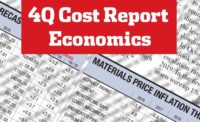Increasingly destructive natural disasters, trade tensions between two of the world’s largest economies, a continued skilled-labor shortage and rising raw-materials prices resulted in higher construction costs in many major markets in 2018, say executives of London-based global construction cost consultant Currie & Brown.
Construction costs in some U.S. markets—notably San Francisco, New York City, Seattle and Portland, Ore.—reached up to 6% escalation through 2018 due to tariffs and a stretched labor market. While high-tech and data-center construction activity is expected to continue to grow in 2019, some sectors are anticipated to decline. Seattle and Portland are expected to see recently hot sectors such as multifamily residential property and mixed-use development cool off through 2019.
In Japan, the hospitality and commercial property sectors are expected to lead construction activity as the country prepares for the 2019 Rugby World Cup and 2020 Olympics. Construction prices rose 9% from May 2017 to May 2018 due to this investment, which is resulting in the worst construction trade labor shortage in Japan since 1993, according to Robert Fuller, Currie & Brown’s managing director of Japan and Taiwan.
The construction labor shortage is impacting countries around the world. As this shortage combines with global trade tensions, construction costs are expected to continue to increase at rates slightly higher than usual.
An added complexity to forecasting how construction costs will change in 2019 are the many different possible outcomes of Brexit and how they impact the global industry. Brexit remains the single biggest factor impacting the U.K. construction sector, as many key decisions are deferred until the manner of Britain’s exit from the European Union, slated to occur next March, is confirmed.
“Skilled labor is at a premium with some shortages exacerbated by a fall in the numbers of East European operatives,” says Richard Hill, a senior Currie & Brown director. This labor shortage resulted in wages rising 2.9% in 2018, increases that have not yet been passed on to construction owners. Output construction costs rose only 2% in 2018, while contractors kept margins low to stay competitive. Material price volatility is an area of concern, as a fall in the pound sterling resulted in material costs increasing 5.8% in 2018, he adds.
|
Related Link |
What Will Brexit Do?
Looking forward into next year, Currie & Brown industry experts forecast that U.K. tender prices will rise 1.8% in 2019 as uncertainty around Brexit slows investment and strains the British economy. It is expected that tender prices will decrease by up to 3% in 2019 if there is a “no-deal” Brexit.
Repercussions of potentially poor trade relationships with EU member countries, uncertain future strength of the pound sterling and rising global commodity prices may cause material costs to increase up to 8% in 2019 in the U.K., a net importer of construction goods. The solution to immigration and citizenship remains unclear and, with its potential to exacerbate the skilled labor shortage, is the principal threat to the future of Britain’s construction industry.
As markets worldwide struggle with rising construction costs thanks to continuing labor shortages, the industry is being pushed to embrace technology and more efficient building methods. Sean Cole, senior director for Currie & Brown in Portland, Ore., notes “an evolution in how the construction industry is now facing up to labor shortage and cost escalation issues.”
Currie & Brown executives say they see an openness by progressive owners to try new methods, such as top-down construction and modular building, that until recently have been largely avoided.



